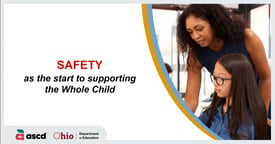Safety and the Whole Child
October is safety month in Ohio schools. Safety is also a key component a whole child approach to education—and one of the five tenets of Ohio’s Whole Child Framework. That tenet reads: Each student learns in an environment that is physically and emotionally safe for students and adults.
Physical safety has been a critical focus in schools in the past few years, and maintaining secure school buildings and surroundings is an essential part of safety. But the Whole Child Framework outlines several other indicators of school safety as well, including trauma-informed policies and practices, student-centered and inclusive school climates, interactions and activities that foster connection and belonging and Positive Behavioral Supports and Intervention.
Let’s take time this month to reflect on how we are working to create conditions in our schools and districts that support physical and emotional safety for all students and adults.
Network Updates .png?width=200&name=Specific-Tenants-350%20(1).png)
The Ohio Whole Child Network is growing!
The Network started in January 2022 as a platform where district and school leaders, community partners, and families could share successes and best practices and support each other in ensuring each child is healthy, safe, engaged, supported, and challenged. At that time, it had 150 members.
As of September 2022, the Network has increased to 300 members. During the Fall of 2023, the network will expand to 450 members.
That growth is indictive of Ohio educators’ commitment to whole child education and the value of connecting with colleagues and sharing ideas and resources to better support students.
To learn more, visit Whole Child Network’s website.
Policy and Funding Updates
- Whole Child Policy Toolkit. The Learning Policy Institute’s Whole Child Policy Toolkit is designed to give state policymakers and education leaders a set of strategies, tools, and resources to advance whole child policy and systems change. Visit wholechildpolicy.org.
- The Safety and Violence Education Students (SAVE Students) Act. The SAVE Students Act calls for a comprehensive approach to school safety involving the Ohio departments of Education, Public Safety, Mental Health and Addiction Services, and the Attorney General’s Office. To learn more, visit Ohio SAVE Students Act.
- The Ohio K-12 School Safety Grant Program. The Ohio Facilities Construction Commission (OFCC), in partnership with the Ohio School Safety Center, is encouraging eligible public schools, districts, and chartered non-public schools statewide to apply to the Ohio K-12 School Safety Grant Program. To learn more, visit the School Safety Grants
- Federal School-Based Mental Health Services Grant Programs. The U.S. Department of Health and Human Services (HHS), through the Substance Abuse and Mental Health Services Administration (SAMHSA), announced funding for school-based mental health. To learn more about funding opportunities, visit the Funding Opportunities for School-Based Mental Health Program.
Podcast 
Fostering Physical and Emotional Safety in Schools
In a special episode of the ASCD Connect podcast, Ohio officials discuss ways educators and schools can better support physical and emotional safety for students and staff, including in the areas of emergency management planning, mental health, and trauma-informed practice. The discussion highlights resources and programs available from the state and provides advice on best practices for improving overall school safety to help students learn and grow.
Podcast Participants:
Emily Eckert, Assistant Director of Prevention, Mental Health, School Climate and Safety, Ohio Department of Education
Jennifer Vargo, Director, Office of Whole Child Supports, Ohio Department of Education
Emily Torok, Executive Director, Ohio School Safety Center
Bobbie Boyer, Deputy Director, Office of Prevention at Ohio
Webinar
Safety as the Start to Supporting the Whole Child
This kick-off webinar provides an introduction to the Ohio Whole Child Network and an in-depth overview of the components and implications of the safety tenet of the Ohio Whole Child Framework. The webinar features a case study from the Marysville Exempted Village School District on integrating student safety and wellness.
Network Member Spotlights
As the Ohio Whole Child Network grows, we would like to showcase the work that member schools and districts are doing in this newsletter. This is an important part of our mission to raise the visibility and impact of efforts to support a whole child approach to education and help our members share ideas and connect with one another.
If you are interested in having us to feature your district, school, or department, please contact Amy Neloms, ASCD's senior manager of professional learning in whole child education, at amy.neloms@ascd.org.
Stories on School Safety From ASCD
Responding to Intolerance Through Community Building
A new study reveals four responses school leaders typically take toward conflict among students—but one rises above the rest for success.
How to Make Your School Psychologically Safe
Four critical steps for nurturing the seeds of inclusivity in school communities.
The Right Mindset for Responding to Student Trauma
Students are struggling with health and wellness like never before. Creating a culture of safety centered around relationships can help.
What Happened to Our Students and What Can We Do About It?
Resilience practice can help our students cope with pandemic-induced trauma.
In the News
- Building Better Schools: Anthony Wayne Schools prioritize mental health, safety for students (Toledo ABC-13)
- A school-based support program coming to Ohio could benefit Lucas County students (Toledo CBS-11)
- Avon police school community on how to take action in emergencies (Cleveland.com)

.png)
